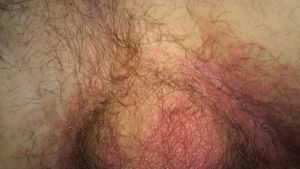We need you! Join our contributor community and become a WikEM editor through our open and transparent promotion process.
Tinea cruris
From WikEM
Contents
Background
- Dermatophyte infection involving the crural fold
- Colloquially known as 'jock itch'
- Most commonly caused by Tinea rubrum
- More common in men than women
- May result from the spread of other concurrent tinea infections
- More common in obese, diabetics, and immunodeficient
Tinea Types
- Tinea capitis (head)
- Tinea corporis (body)
- Tinea pedis (foot)
- Tinea cruris (groin)
Clinical Features
- Begins with an erythematous patch on the proximal medial thigh
- Inward spread with partial central clearing
- Sharply demarcated border, erythematous, elevated
- May spread to perineum, perianally, onto buttocks, or into gluteal cleft
- Typically spares the scrotum
Differential Diagnosis
- Erythrasma (Coral red fluorescence with Wood's lamp)
- Seborrheic dermatitis
- Candidal intertrigo (Erythematous patches with satellite lesions)
- Inverse psoriasis
Testicular Diagnoses
- Testicular torsion
- Epididymitis
- Orchitis
- Torsion of testicular appendage
- Scrotal abscess
- Fournier gangrene
- Hydrocele
- Indirect inguinal hernia
- Hematocele
- Spermatocele
- Testicular trauma
- Testicular rupture
- Varicocele
- Inguinal lymph node (Lymphadenitis)
- Testicular tumor
- Cellulitis
- Tinea cruris
Vulvovaginitis
- Bacterial vaginosis
- Candida vaginitis
- Trichomonas vaginalis
- Contact vulvovaginitis
- Atrophic vaginitis
- Lichen sclerosus
- Tinea cruris
- Chlamydia/Gonorrhea infection
Evaluation
- Typically a clinical diagnosis
- Scraped skin from affected area in KOH prep will show segmented hyphae
Management
- Topical antifungals: Clotrimazole, terbinafine
- treatment to reduce symptoms, prevent secondary bacterial infection, and limit spread
- Systemic antifungals reserved for patients who fail topical therapy
- Systemic antifungals that can be used include: terbinafine, itraconazole, and fluconazole
Disposition
- Outpatient
See Also
References
UpToDate, Tinitnalli's

